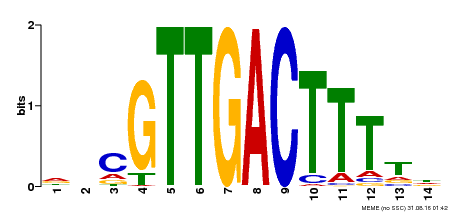 |
PlantRegMap/PlantTFDB v5.0
Plant Transcription
Factor Database
|
| Home TFext BLAST Prediction Download Help About Links PlantRegMap |
Transcription Factor Information
| Basic Information? help Back to Top | |||||||||
|---|---|---|---|---|---|---|---|---|---|
| TF ID | maker-scaffold03409-augustus-gene-0.16-mRNA-1 | ||||||||
| Organism | |||||||||
| Taxonomic ID | |||||||||
| Taxonomic Lineage |
cellular organisms; Eukaryota; Viridiplantae; Streptophyta; Streptophytina; Embryophyta; Tracheophyta; Euphyllophyta; Spermatophyta; Magnoliophyta; Mesangiospermae; eudicotyledons; Gunneridae; Pentapetalae; rosids; fabids; Fagales; Fagaceae; Castanea
|
||||||||
| Family | WRKY | ||||||||
| Protein Properties | Length: 334aa MW: 36316.1 Da PI: 10.0828 | ||||||||
| Description | WRKY family protein | ||||||||
| Gene Model |
|
||||||||
| Signature Domain? help Back to Top | |||||||
|---|---|---|---|---|---|---|---|
| No. | Domain | Score | E-value | Start | End | HMM Start | HMM End |
| 1 | WRKY | 96.9 | 1.4e-30 | 257 | 314 | 3 | 59 |
-SS-EEEEEEE--TT-SS-EEEEEE-ST.T---EEEEEE-SSSTTEEEEEEES--SS- CS
WRKY 3 DgynWrKYGqKevkgsefprsYYrCtsa.gCpvkkkversaedpkvveitYegeHnhe 59
D+y+WrKYGqK++kgs++pr+YY+C++ gCp++k+ver+ +dpk++++tYe eH+h+
maker-scaffold03409-augustus-gene-0.16-mRNA-1 257 DEYSWRKYGQKPIKGSPYPRGYYKCSTIrGCPARKHVERAPDDPKMLIVTYEAEHRHS 314
9************************9877****************************7 PP
| |||||||
| Protein Features ? help Back to Top | ||||||
|---|---|---|---|---|---|---|
| Database | Entry ID | E-value | Start | End | InterPro ID | Description |
| Pfam | PF10533 | 3.5E-20 | 205 | 253 | IPR018872 | Zn-cluster domain |
| Gene3D | G3DSA:2.20.25.80 | 2.6E-32 | 243 | 315 | IPR003657 | WRKY domain |
| PROSITE profile | PS50811 | 31.95 | 250 | 316 | IPR003657 | WRKY domain |
| SuperFamily | SSF118290 | 1.02E-25 | 253 | 315 | IPR003657 | WRKY domain |
| SMART | SM00774 | 5.9E-35 | 255 | 315 | IPR003657 | WRKY domain |
| Pfam | PF03106 | 5.9E-26 | 257 | 313 | IPR003657 | WRKY domain |
| Gene Ontology ? help Back to Top | ||||||
|---|---|---|---|---|---|---|
| GO Term | GO Category | GO Description | ||||
| GO:0006355 | Biological Process | regulation of transcription, DNA-templated | ||||
| GO:0009737 | Biological Process | response to abscisic acid | ||||
| GO:0009938 | Biological Process | negative regulation of gibberellic acid mediated signaling pathway | ||||
| GO:0010200 | Biological Process | response to chitin | ||||
| GO:0042742 | Biological Process | defense response to bacterium | ||||
| GO:0003700 | Molecular Function | transcription factor activity, sequence-specific DNA binding | ||||
| GO:0005516 | Molecular Function | calmodulin binding | ||||
| GO:0043565 | Molecular Function | sequence-specific DNA binding | ||||
| GO:1990841 | Molecular Function | promoter-specific chromatin binding | ||||
| Sequence ? help Back to Top |
|---|
| Protein Sequence Length: 334 aa Download sequence Send to blast |
MAVDLLGFPK MDDQTAIQEA TSQGLRSMEH LIRFMSNRPN HMDCSDLTDH TVAKFKKVIS 60 LLNRTGHARF RRGPFRPSAS PSSSDDSIFV PHSQTLNLAP TPSAPVVVPT TVSQISITAP 120 PSYVSHPQSL TLDFTKPNAF ASNAKASELD YAKESFSVSS SSSFMSSAIT GDGSVSNGKL 180 GTSIFVSPAP AVSGGKPPLS SAPYKKRCHE HEHEHSGKFS GSGSGSKCHC SKRRKNRVKR 240 TIRVPAISSK IADIPPDEYS WRKYGQKPIK GSPYPRGYYK CSTIRGCPAR KHVERAPDDP 300 KMLIVTYEAE HRHSGPLAMQ ENVTTGVGLV FEST |
| 3D Structure ? help Back to Top | ||||||
|---|---|---|---|---|---|---|
| PDB ID | Evalue | Query Start | Query End | Hit Start | Hit End | Description |
| 2ayd_A | 2e-21 | 243 | 316 | 2 | 74 | WRKY transcription factor 1 |
| Search in ModeBase | ||||||
| Functional Description ? help Back to Top | ||||||
|---|---|---|---|---|---|---|
| Source | Description | |||||
| UniProt | Transcription factor. Interacts specifically with the W box (5'-(T)TGAC[CT]-3'), a frequently occurring elicitor-responsive cis-acting element (By similarity). Regulates rhizobacterium B.cereus AR156-induced systemic resistance (ISR) to P.syringae pv. tomato DC3000, probably by activating the jasmonic acid (JA)- signaling pathway (PubMed:26433201). {ECO:0000250, ECO:0000269|PubMed:26433201}. | |||||
| Binding Motif ? help Back to Top | |||
|---|---|---|---|
| Motif ID | Method | Source | Motif file |
| MP00464 | DAP | Transfer from AT4G31550 | Download |

| |||
| Regulation -- Description ? help Back to Top | ||||||
|---|---|---|---|---|---|---|
| Source | Description | |||||
| UniProt | INDUCTION: Strongly during leaf senescence (PubMed:11722756). Repressed by rhizobacterium B.cereus AR156 in leaves, and to a lower extent, by P.fluorescens WCS417r (PubMed:26433201). {ECO:0000269|PubMed:11722756, ECO:0000269|PubMed:26433201}. | |||||
| Regulation -- PlantRegMap ? help Back to Top | ||||||
|---|---|---|---|---|---|---|
| Source | Upstream Regulator | Target Gene | ||||
| PlantRegMap | Retrieve | Retrieve | ||||
| Annotation -- Protein ? help Back to Top | |||||||
|---|---|---|---|---|---|---|---|
| Source | Hit ID | E-value | Description | ||||
| Refseq | XP_023896945.1 | 0.0 | probable WRKY transcription factor 17 | ||||
| Swissprot | Q9SV15 | 1e-144 | WRK11_ARATH; Probable WRKY transcription factor 11 | ||||
| TrEMBL | A0A2N9FAI9 | 1e-176 | A0A2N9FAI9_FAGSY; Uncharacterized protein | ||||
| STRING | cassava4.1_011135m | 1e-163 | (Manihot esculenta) | ||||
| Orthologous Group ? help Back to Top | |||
|---|---|---|---|
| Lineage | Orthologous Group ID | Taxa Number | Gene Number |
| Fabids | OGEF1314 | 34 | 98 |
| Best hit in Arabidopsis thaliana ? help Back to Top | ||||||
|---|---|---|---|---|---|---|
| Hit ID | E-value | Description | ||||
| AT4G31550.2 | 1e-113 | WRKY DNA-binding protein 11 | ||||



